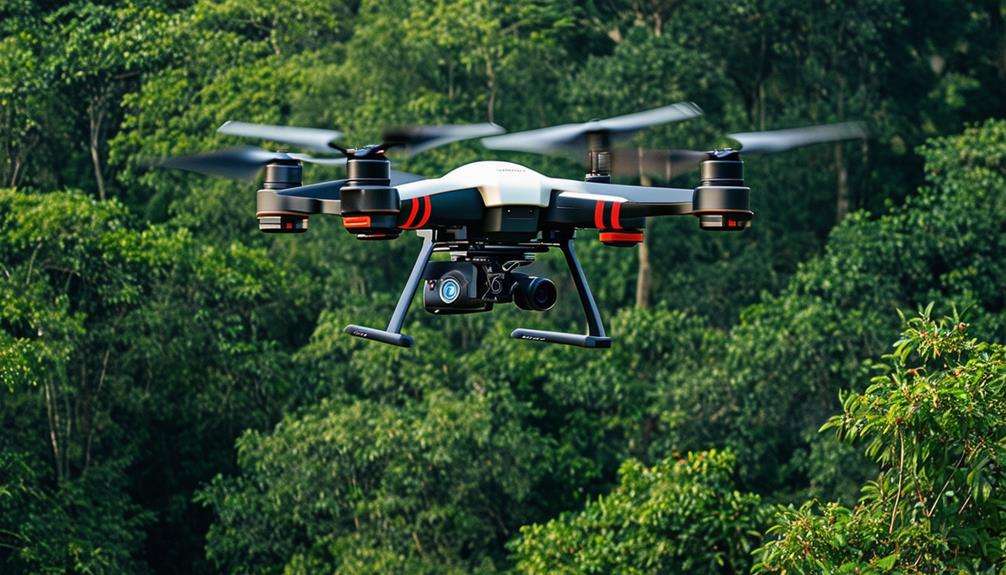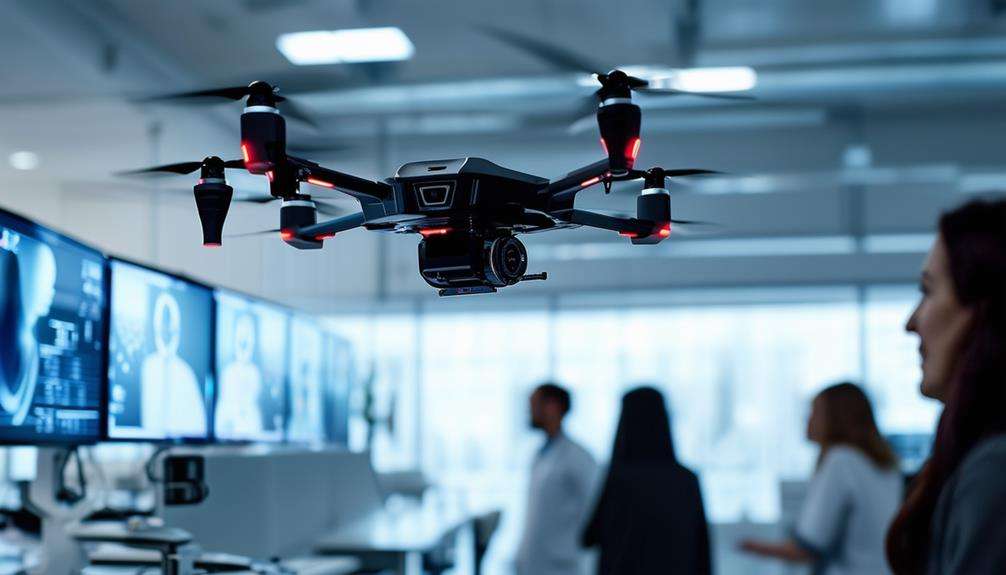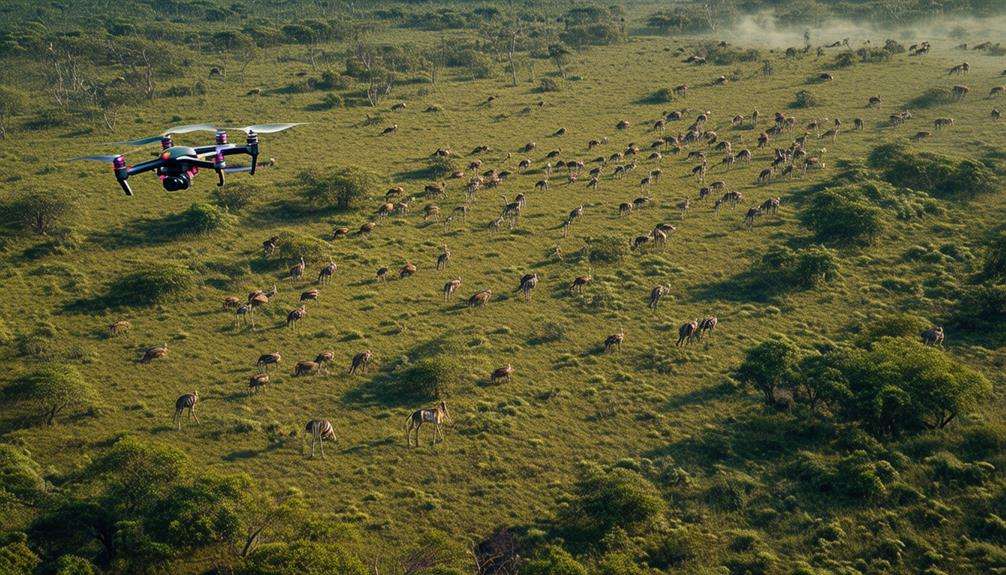The Role of Drones in Modern Warfare: A Historical Perspective
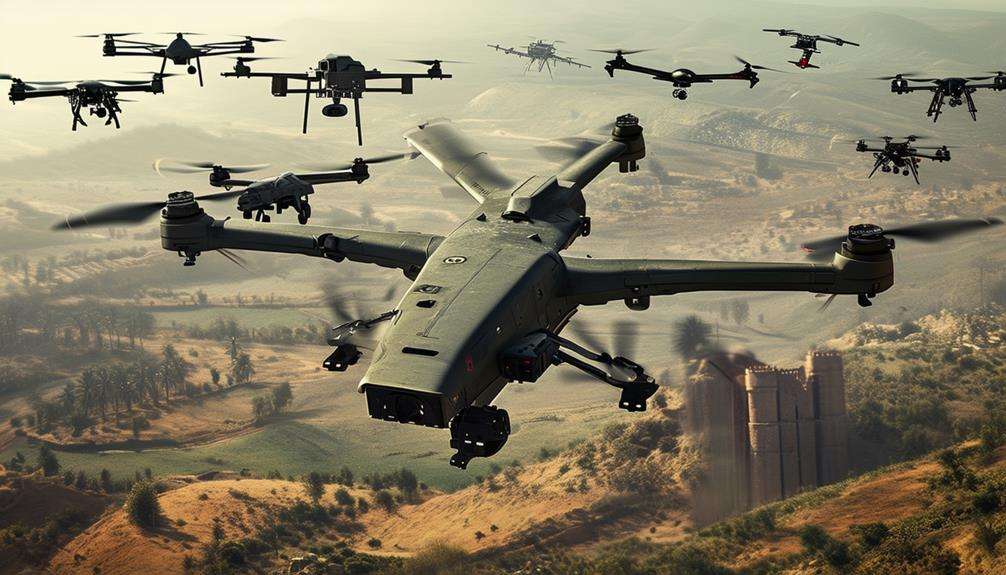
Drones might seem like a recent innovation, but their origins trace back to 1849 when Austrian forces utilized unmanned balloons to carry explosives.
The concept evolved during World War II with the deployment of V-1 flying bombs.
The Cold War era saw drones primarily used for reconnaissance missions.
In contemporary times, drones have expanded their roles to include intelligence gathering and delivering precise strikes, often resulting in minimal collateral damage.
Curious about how these technological advancements have transformed modern combat strategies and what the future may hold? Let's explore how drones have revolutionized warfare through the decades.
Early Innovations
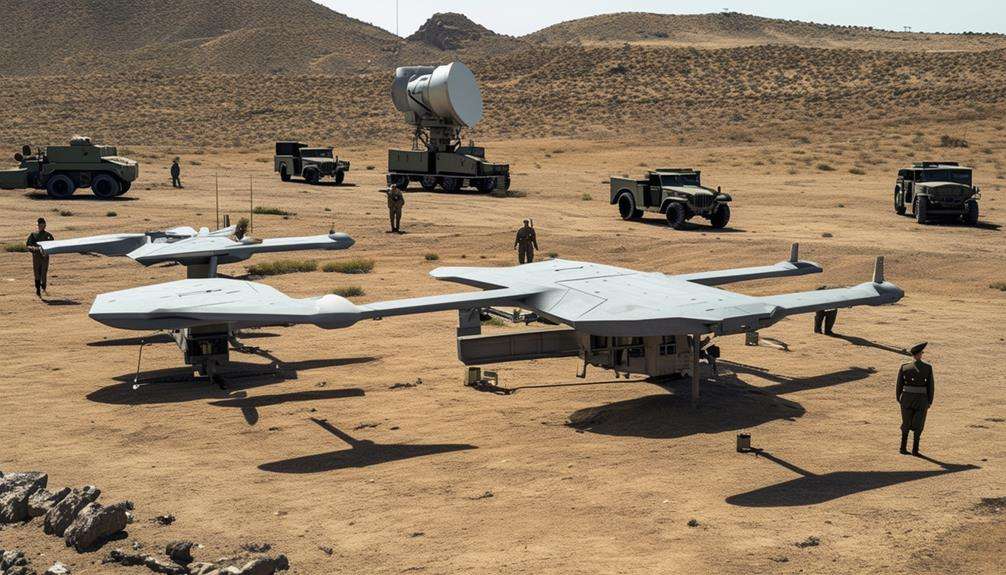
The inception of aerial drones in warfare traces back to 1849 when Austrian forces first employed them in combat. Interestingly, the initial 'drone' was essentially a balloon loaded with explosives, aimed at Venice. Although primitive and not entirely effective, it marked a noteworthy milestone in military innovation.
Fast forward to World War I, and drone technology had significantly progressed. British engineer Archibald Lowe pioneered the first radio-controlled drones, called Aerial Targets, designed to test anti-aircraft defenses. This development represented a substantial advancement from the Austrian balloons, highlighting the rapid evolution of drone technology.
During the interwar period, the British continued to innovate with the creation of Queen Bees, radio-controlled aircraft used for target practice. These Queen Bees directly influenced American advancements in drone technology, paving the way for more sophisticated developments.
World War II Developments
During World War II, early drone technology was employed primarily for surveillance and reconnaissance missions, marking a significant shift in military strategy.
These early drones were crucial in gathering intelligence and informing tactical decisions, setting the stage for the advanced unmanned aerial vehicles used today.
Early Drone Technology
During World War II, the British pioneered drone technology with the development of the Queen Bee, a target practice drone that laid the groundwork for future advancements in unmanned aerial vehicles (UAVs). The Queen Bee was a radio-controlled aircraft used to train anti-aircraft gunners, showcasing early UAV versatility.
In 1946, drones based on B-17 Flying Fortress airframes set endurance records, demonstrating significant advancements in unmanned flight capabilities. These early UAVs proved that extended flight durations were achievable, a critical factor in their evolution.
By 1961, the Canberra U Mk 10 jet plane emerged as a pilotless drone for target location during missile trials, representing a significant leap from the Queen Bee. This development highlighted the increasing complexity and utility of drone technology for various military applications beyond training.
These early advancements in drone technology during and shortly after World War II marked the beginning of a new era in military strategy and technology, laying the foundation for the sophisticated drones used in modern warfare.
Surveillance and Reconnaissance
Drones played a pivotal yet often overlooked role in surveillance and reconnaissance during World War II, providing invaluable intelligence to military forces. British forces actively utilized drones for reconnaissance, marking the early development and use of drone technology. These unmanned aerial vehicles (UAVs) were instrumental in identifying enemy positions and gathering critical intelligence, significantly contributing to military decision-making and strategic planning.
One notable example is the Midge Surveillance Drone. Equipped with rocket-powered flight and pre-programmed path capabilities, it performed aerial reconnaissance for the British Army and laid the groundwork for modern drone technology in warfare. The intelligence gathered by these early drones was essential for battlefield awareness and operational success.
To give you a clearer understanding, here's a table highlighting key developments:
| Drone | Features | Role |
|---|---|---|
| Early WWII Drones | Basic reconnaissance capabilities | Identifying enemy positions |
| Midge | Rocket-powered, pre-programmed | Aerial reconnaissance |
| Canberra U Mk 10 | Pilotless drone conversion | Naval missile trials |
| Intelligence Use | Battlefield awareness | Military decision-making |
These early surveillance and reconnaissance efforts were foundational in shaping the sophisticated drone technology seen in modern warfare today.
The Cold War Era
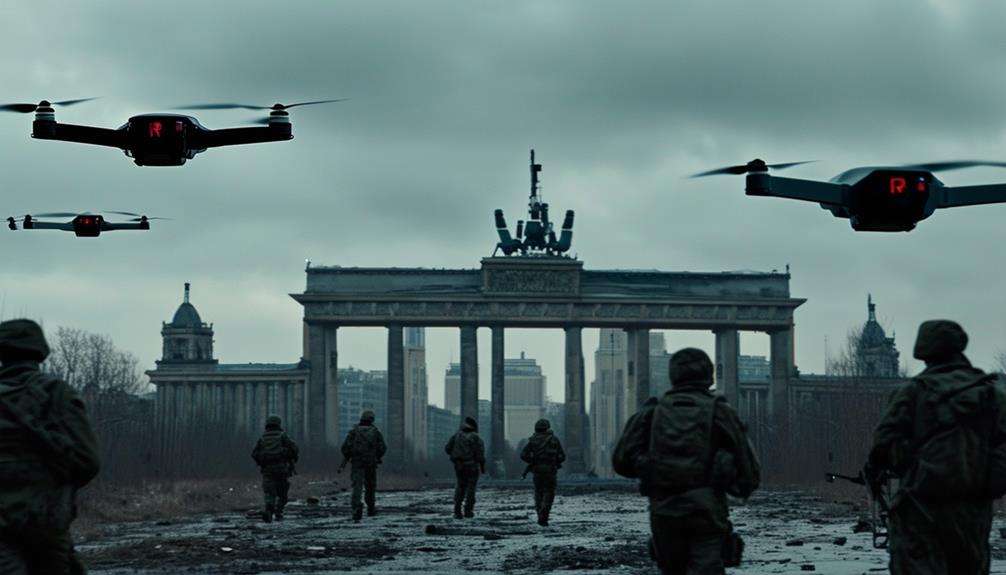
During the Cold War, countries increasingly utilized drones for reconnaissance missions, significantly enhancing their surveillance capabilities and intelligence-gathering operations. This era witnessed notable advancements in drone technology, which substantially altered the landscape of warfare. By deploying drones, nations could monitor enemy activities without risking human lives, offering a safer and more efficient approach to intelligence collection.
Drones were integral to Cold War military strategies, enabling:
- Real-time surveillance: Providing immediate visual and electronic intelligence crucial for strategic decision-making.
- Border monitoring: Patrolling borders and no-fly zones to ensure constant vigilance and rapid response to threats.
- Data collection: Gathering vital information on enemy movements, installations, and capabilities to inform military tactics.
The use of drones during the Cold War extended beyond mere espionage; it was about maintaining a strategic advantage. By leveraging drone technology, countries could stay ahead of their adversaries and adapt to the evolving dynamics of global warfare.
The innovations in drone technology during this period laid the foundation for the sophisticated drone warfare seen today, marking a pivotal shift in military operations and setting the stage for a modern, technology-driven military landscape.
Technological Milestones
The pivotal technological milestones in drone development are impossible to overlook. Early innovations such as the Aerial Target and Queen Bee during WWI laid the foundation for future advancements.
Achievements in endurance records and sophisticated remote control systems have continually enhanced drone capabilities, significantly impacting modern warfare.
Early Drone Innovations
Early drone innovations laid the groundwork for modern UAV technology, beginning with the British Aerial Target and Queen Bee during WWI. These early radio-controlled aircraft were developed for training and target practice, showcasing the potential of unmanned systems in military operations. Understanding these pioneering efforts is crucial when exploring the evolution of drones.
During the Second World War, advancements continued to shape drone technology. For instance, in 1946, a drone prototype based on a B-17 Flying Fortress airframe set an endurance record. This milestone highlighted the growing capabilities of unmanned aerial vehicles (UAVs) for extended missions, paving the way for future developments.
Key points to consider:
- WWI Innovations: The British Aerial Target and Queen Bee set the stage for drone development.
- Second World War Milestones: A B-17 drone prototype showcased significant advancements in endurance and capability.
- Post-War Progress: The Canberra U Mk 10 jet plane was utilized as a pilotless drone, further pushing technological boundaries.
These early drone innovations were instrumental in shaping the UAV technology we see today, proving that the foundation of modern drones was built on decades of continuous improvement.
Breakthroughs in Drone Technology
Technological breakthroughs in drone technology have revolutionized modern warfare, leading to significant advancements in capabilities and applications. Since the early stages of development, drones have continuously evolved.
In 1946, a prototype based on a B-17 Flying Fortress set an endurance record, marking an early milestone in drone technology. This achievement demonstrated the potential for long-duration missions, laying the groundwork for future innovations.
By the 1980s, remotely piloted vehicles (RPVs) emerged as a game-changer. These drones could be controlled via keypad and joystick, offering unprecedented precision and control. This breakthrough fundamentally changed how drones were utilized in modern warfare, enhancing their operational effectiveness.
During Operation Herrick XVI in Afghanistan, the Watchkeeper UAV, operated by the Royal Artillery, showcased the integration of drones in intelligence and surveillance roles. This UAV provided essential real-time data, underscoring the importance of drones in modern military operations.
Today, drones have diversified into reconnaissance, combat, and target acquisition roles, becoming indispensable tools in modern warfare. They offer persistent surveillance, precision strikes, reduced risk to personnel, and rapid deployment. These technological milestones have undeniably transformed military strategies and operational dynamics, marking the beginning of a new era in warfare.
Advanced Drone Capabilities
Recent breakthroughs in drone technology have revolutionized modern warfare by enhancing the capabilities of Unmanned Aerial Vehicles (UAVs). These advancements have led to precision strike capabilities, persistent surveillance, and rapid deployment, significantly improving decision-making and operational effectiveness on the battlefield.
Key advancements in drone technology include:
- Precision Strikes: UAVs now deliver pinpoint accuracy in strikes, minimizing collateral damage and increasing mission success rates.
- Persistent Surveillance: Modern drones provide continuous, real-time intelligence, surveillance, and reconnaissance (ISR), which is crucial for effective battlefield management.
- Quick Deployment: The ability to deploy drones rapidly offers strategic advantages, allowing military forces to respond swiftly to emerging threats.
The evolution from the 1980s' remotely piloted vehicles (RPVs) with basic controls to today's sophisticated drones marks significant technological milestones. For example, the Watchkeeper UAV, employed by the Royal Artillery in Afghanistan, demonstrated advanced ISR capabilities, highlighting the progress in drone technology.
These advancements underscore the critical role of UAVs in contemporary conflicts, where they serve various functions from reconnaissance to combat missions. Drones have become indispensable in modern warfare, continually evolving in their technological capabilities and significantly impacting military strategies.
Modern Combat Applications
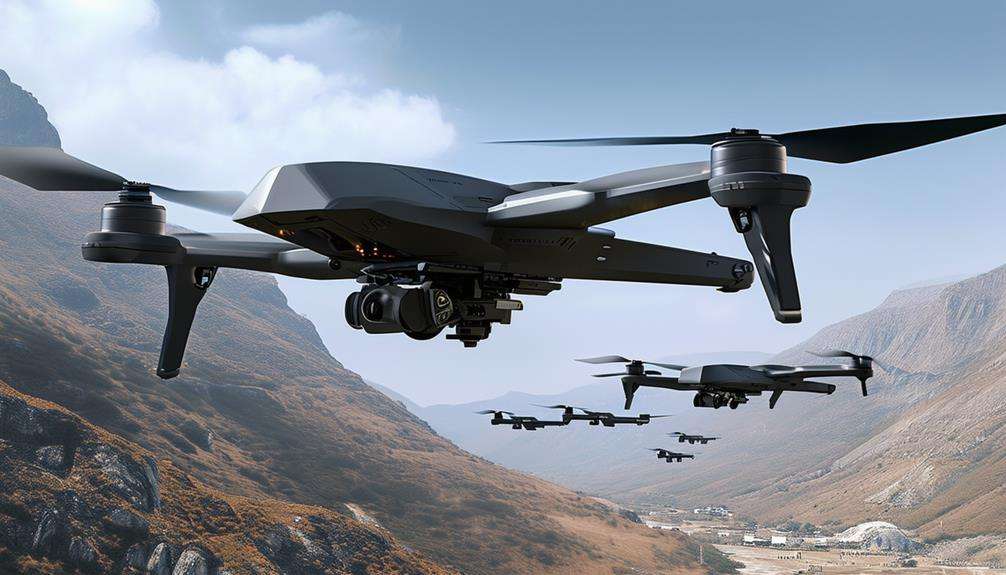
Drones have revolutionized modern combat by offering unparalleled surveillance, precision strikes, and reduced risks to military personnel. In the United States, drone warfare has become a fundamental component of military strategy. These unmanned aerial vehicles (UAVs) are extensively utilized for surveillance, intelligence gathering, and targeted strikes, making them indispensable in contemporary combat scenarios.
Different types of drones serve various military purposes. Reconnaissance drones provide persistent surveillance capabilities, enabling the monitoring of enemy movements and the collection of critical intelligence without endangering personnel. Combat drones, on the other hand, specialize in precision strikes, capable of eliminating high-value targets with minimal collateral damage—an attribute highly valued in counterterrorism operations.
Drones also play a crucial role in border security, delivering real-time data that enhances military decision-making. Their continuous surveillance capabilities help maintain a strategic advantage over adversaries.
However, drone warfare isn't without its challenges. Legal and ethical issues, such as accountability and transparency, continue to be significant concerns. Additionally, drones are susceptible to hacking, and the psychological impact of constant surveillance is considerable.
Tactical and Operational Impact
Leveraging their advanced capabilities, Unmanned Aerial Vehicles (UAVs) have revolutionized tactical operations by enabling long-distance enemy engagement and minimizing direct risks to military personnel. Utilizing UAVs for reconnaissance, intelligence gathering, and precision strikes enhances strategic advantages while reducing casualties among troops. Recent conflicts, such as the Russian-Ukrainian war, highlight the critical role drones play in shaping battlefield outcomes.
UAVs' tactical and operational impacts include:
- Enhanced Reconnaissance: Collect real-time intelligence without exposing soldiers to danger.
- Precision Strikes: Accurately target enemy positions, minimizing collateral damage and civilian casualties.
- Force Preservation: Undertake high-risk tasks, safeguarding personnel from direct combat.
With advancements in drone technology, including AI integration and resilience to electronic warfare, UAVs have become even more crucial in modern warfare. These innovations ensure UAVs remain effective despite electronic warfare challenges, providing indispensable tools on the battlefield.
Future Trends in Drone Warfare
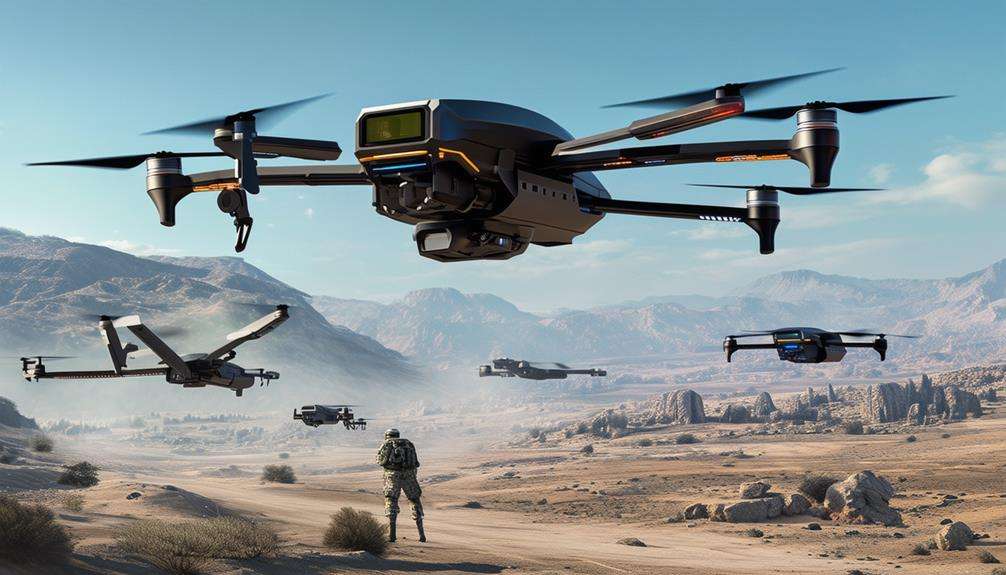
As UAVs have solidified their role in modern conflicts, the future of drone warfare promises even more sophisticated technologies and strategic applications. One of the most significant advancements will be the integration of artificial intelligence, enabling drones to make autonomous decisions during combat. This means drones won't just follow preset paths; they'll adapt in real-time, making them even more formidable.
Experts predict that improved resistance to electronic warfare will be essential. Future drones will have enhanced defenses against jamming and hacking, ensuring they remain operational in hostile environments. This will be crucial for maintaining the reliability of these assets during missions.
Drones are also expected to take on more roles in long-range precision strikes. Armed with guided missiles, these UAVs will execute precise and devastating attacks from greater distances, reshaping military strategies. Additionally, their ability to gather and relay information will integrate them seamlessly into reconnaissance-strike complexes, improving coordination and effectiveness on the battlefield.
Conclusion
In summary, drones have evolved from early innovations to indispensable tools in modern warfare. Their development spans from World War II and the Cold War to various technological breakthroughs.
Today's drones provide unmatched intelligence, precision, and strategic advantages. As technology advances, future drones will continue to shape military tactics and operations.
Drones aren't just altering the landscape of warfare; they're defining its future.


